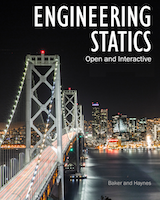Skip to main content \(\require{cancel}\let\vecarrow\vec
\renewcommand{\vec}{\mathbf}
\newcommand{\ihat}{\vec{i}}
\newcommand{\jhat}{\vec{j}}
\newcommand{\khat}{\vec{k}}
\DeclareMathOperator{\proj}{proj}
\newcommand{\kg}[1]{#1~\mathrm{kg} }
\newcommand{\lbm}[1]{#1~\mathrm{lbm} }
\newcommand{\slug}[1]{#1~\mathrm{slug}}
\newcommand{\m}[1]{#1~\mathrm{m}}
\newcommand{\km}[1]{#1~\mathrm{km}}
\newcommand{\cm}[1]{#1~\mathrm{cm}}
\newcommand{\mm}[1]{#1~\mathrm{mm}}
\newcommand{\ft}[1]{#1~\mathrm{ft}}
\newcommand{\inch}[1]{#1~\mathrm{in}}
\newcommand{\N}[1]{#1~\mathrm{N} }
\newcommand{\kN}[1]{#1~\mathrm{kN} }
\newcommand{\MN}[1]{#1~\mathrm{MN} }
\newcommand{\lb}[1]{#1~\mathrm{lb} }
\newcommand{\lbf}[1]{#1~\mathrm{lbf} }
\newcommand{\Nm}[1]{#1~\mathrm{N}\!\cdot\!\mathrm{m} }
\newcommand{\kNm}[1]{#1~\mathrm{kN}\!\cdot\!\mathrm{m} }
\newcommand{\ftlb}[1]{#1~\mathrm{ft}\!\cdot\!\mathrm{lb} }
\newcommand{\ftlbf}[1]{#1~\mathrm{ft}\!\cdot\!\mathrm{lbf} }
\newcommand{\inlb}[1]{#1~\mathrm{in}\!\cdot\!\mathrm{lb} }
\newcommand{\lbperft}[1]{#1~\mathrm{lb}/\mathrm{ft} }
\newcommand{\lbperin}[1]{#1~\mathrm{lb}/\mathrm{in} }
\newcommand{\Nperm}[1]{#1~\mathrm{N}/\mathrm{m} }
\newcommand{\kNperm}[1]{#1~\mathrm{kN}/\mathrm{m} }
\newcommand{\kgperkm}[1]{#1~\mathrm{kg}/\mathrm{km} }
\newcommand{\psinch}[1]{#1~\mathrm{lb}/\mathrm{in}^2 }
\newcommand{\pqinch}[1]{#1~\mathrm{lb}/\mathrm{in}^3 }
\newcommand{\psf}[1]{#1~\mathrm{lb}/\mathrm{ft}^2 }
\newcommand{\pqf}[1]{#1~\mathrm{lb}/\mathrm{ft}^3 }
\newcommand{\Nsm}[1]{#1~\mathrm{N}/\mathrm{m}^2 }
\newcommand{\kgsm}[1]{#1~\mathrm{kg}/\mathrm{m}^2 }
\newcommand{\kgqm}[1]{#1~\mathrm{kg}/\mathrm{m}^3 }
\newcommand{\Pa}[1]{#1~\mathrm{Pa} }
\newcommand{\kPa}[1]{#1~\mathrm{kPa} }
\newcommand{\aSI}[1]{#1~\mathrm{m}/\mathrm{s}^2 }
\newcommand{\aUS}[1]{#1~\mathrm{ft}/\mathrm{s}^2 }
\newcommand{\unit}[1]{#1~\mathrm{unit} }
\newcommand{\ang}[1]{#1^\circ }
\newcommand{\second}[1]{#1~\mathrm{s} }
\newcommand{\lt}{<}
\newcommand{\gt}{>}
\newcommand{\amp}{&}
\definecolor{fillinmathshade}{gray}{0.9}
\newcommand{\fillinmath}[1]{\mathchoice{\colorbox{fillinmathshade}{$\displaystyle \phantom{\,#1\,}$}}{\colorbox{fillinmathshade}{$\textstyle \phantom{\,#1\,}$}}{\colorbox{fillinmathshade}{$\scriptstyle \phantom{\,#1\,}$}}{\colorbox{fillinmathshade}{$\scriptscriptstyle\phantom{\,#1\,}$}}}
\)
Section 8.9 Geogebra Interactives
You can use the interactives below to practice drawing shear and bending moment diagrams. You can change the position of the loads and change their magnitudes and observe how the diagrams change, or you can click
New Problem to generate a new problem.
After exploring the diagrams and seeing how they relate to each other, turn off the solutions and try for yourself. You will very likely see problems like these on an exam.
Subsection 8.9.1 Concentrated Forces
Instructions.
\(A\) and
\(B\) are the supports.
\(C\text{,}\) \(D\text{,}\) and
\(E\) are the loads.
Subsection 8.9.2 Concentrated Force and Moment
Subsection 8.9.3 Distributed Load
Instructions.
\(A\) and
\(F\) are the reaction forces.
Subsection 8.9.4 Combination Load
Instructions.
\(A\) and
\(F\) are the reaction forces.
Subsection 8.9.5 Arbitrary Load
Instructions.
The load
\(w\) is a function of
\(x\text{.}\)
This applet uses the sign convention that positive loads act down, so
\begin{equation*}
\dfrac{dV}{dx} = - w(x)\text{.}
\end{equation*}

